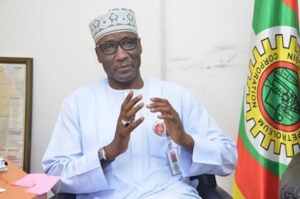
The Nigerian National Petroleum Corporation (NNPC) yesterday vigorously defended the approval of a whopping $1.5 billion for the rehabilitation of the Port Harcourt refinery, maintaining that apart from following due process, building a new refinery in the class of the one in Rivers will cost the federal government between $7 billion and $12 billion.
Group Managing Director of the corporation, Mallam Mele Kyari, who spoke in Abuja, stated that the decision to revamp the old facility was further taken because constructing a new refinery will take a period of four years, during which Nigeria must continue to import products.
The NNPC helmsman argued that there was no basis for comparison between the Port Harcourt refinery and the one sold by Shell in America for $1.2 billion in terms of capacity, describing the public comments emanating thereof as curious.
He disclosed that the actual cost of the project is about $1.34 billion, noting that the additional expenses include taxes and other duties that could come up.
“The real cost is $1.34 billion. Even then you could argue and say why you wouldn’t build a new refinery. We have also seen some curious comparisons that shell sold one of its refineries for $1.2 billion and that it’s even better than our own.
“This is mundane. Even a Google search will reveal that it was built in 1915 and it’s a 107,000 barrels per day refinery. It has been on shut down by the regulators since early last year. Not only that, when you buy a refinery you buy its assets and the liabilities,” he argued.
He maintained that many people do not know the financial transactions that go into some negotiations, saying that it is needless to compare a combined refinery of 210, 000 barrels to a much smaller and much older refinery which has many issues with regulators.
“Simple due diligence was not conducted before those comments were made. They have asked why we don’t just build a new one. What does it take to build a refinery of this status today? It’s anywhere between $7 billion to $12 billion to construct a refinery of this nature. This is what we call battery limit construction. That’s the estimate you see in the public space.
“There are things you do outside the battery limits like the tank and other utilities that are never accounted for when the estimates of this nature are done. That’s about 25 per cent of the total cost. So, when you say refineries can be built for $6 billion or even $10 billion, you should also think about the 25 per cent you will add to it,” Kyari said.
He said that another option would have been to scrap the current one and build a new one, but added that the resources are not available while the banking sector is not ready to put in the money because they no longer fund oil projects of that magnitude.
Kyari said that the refineries are national assets that must be used to ensure energy security for the country, maintaining that if a new refinery is started, it cannot become functional in less than four years, which means Nigeria will keep importing in the next four years.
According to him, even for national strategic purposes, that would be a wrong decision, with the last turn-around-maintenance of the Port Harcourt having been done 21 years ago.
The GMD stated that the current huge cost of rehabilitation was because the last turn-around-maintenance was badly carried out.
He posited that all stakeholders and agencies of the government were involved in the process leading to the award, saying that it wasn’t a TAM that was currently being carried out but total rehabilitation, which means that major components will be replaced, new items will be introduced and an upgrade of the plant.
Kyari argued that the process went through the Bureau of Public Procurement and other such bodies, saying that he was confident that the best decision was taken after the tender process.
He stressed that the process was delayed for the past 10 years because of unwarranted interferences and strategy problems, including going to the original refinery builders, which he said was the wrong thing to do.
Kyari said that the borrowing angle was introduced because typically, lenders will give conditions, one of which is an Operations and Maintenance contract arrangement, meaning that NNPC will not operate the plant, as it will be done in consonance with what he described as the best global practice.
“More than that, the contractors will give a guarantee that it will work for such a period of time. That’s part of the requirements which was absent in previous ones under the TAM arrangements,” he said.
He vowed that the plant will work and the loans will be repaid, saying that he was confident that in the next 15 years, the plant will still be running.
The NNPC helmsman said in 18 months, gas will be obtained from the plant and will eventually, scale up until the contractors leave the site, unlike a new one that will require the whole plant to be completed before it starts functioning.
According to him, the loan will be repaid from when the refinery becomes functional, adding that a refinery can produce a margin of $4-$7 per barrel which will be used to finance the loan.
“What we have done is to put in place a transparent process. This has not always been done. The EPC contract was thrown open. It has never been done. We have invited McKenzie to support us. We have taken the control from the NNPC, including the selection of EPC contractors,” he said.

Leave a Reply